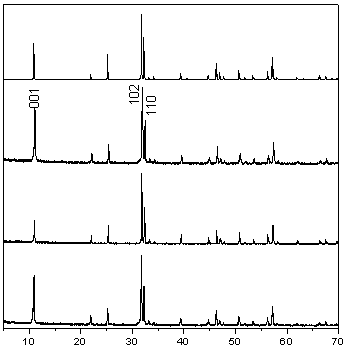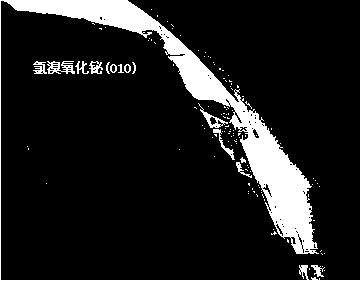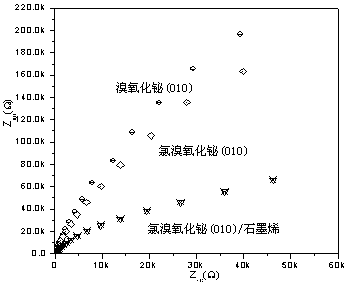Bismuth oxychlorobromide (010)/graphene heterojunction, and preparation method and application thereof
A kind of technology of bismuth oxychlorobromide and bismuth oxybromide, applied in the field of bismuth oxychlorobromide/graphene heterojunction and preparation thereof, can solve the problem that no report, no patent and literature report bismuth oxychlorobromide (010)/graphite The preparation method and application of ene heterojunction, etc., to achieve the effects of low cost, improved photocatalytic performance, and easy size
- Summary
- Abstract
- Description
- Claims
- Application Information
AI Technical Summary
Problems solved by technology
Method used
Image
Examples
Embodiment 1
[0037] Step 1, take 0.050g of commercial graphene and add it into deionized water, ultrasonically disperse at 30°C for 15min, the ultrasonic power is 65W, and then continue to stir for 35min to make A liquid;
[0038] Step 2, 5mmol of Bi(NO 3 ) 3 ·5H 2 O was added to 2.0 mol / L HNO 3 , stirred at 70°C until completely dissolved, and the stirring time was 60 minutes, and made into liquid B;
[0039] Step 3, take 4.95mmol KBr and 0.05mmol KCl and dissolve in deionized water to make C solution, wherein Bi(NO 3 ) 3 ·5H 2 The molar ratio of O to (KBr+KCl) is 1:1;
[0040] Step 4: Slowly add the prepared liquid A to liquid B dropwise at a rate of 14 drops / min, and stir while adding. After the dropwise addition, ultrasonically disperse at 30°C with a power of 65W for 20 minutes, and then stir for 30 minutes. into D liquid;
[0041] Step 5, slowly drop 2.0 mol / L NaOH solution into D liquid at a rate of 14 drops / min, adjust the pH value of D liquid to 6, and continue stirring fo...
Embodiment 2
[0046] Step 1: Add 0.055g of commercial graphene into deionized water, ultrasonically disperse at 35°C for 20min, the ultrasonic power is 70W, and then continue to stir for 40min to make A solution;
[0047] Step 2, 5mmol of Bi(NO 3 ) 3 ·5H 2 O was added to 2.5 mol / L HNO 3 , stirred at 75°C until completely dissolved, and the stirring time was 65 minutes, and made into liquid B;
[0048] Step 3, take 4.90mmol KBr and 0.10mmol KCl and dissolve in deionized water to make C solution, wherein Bi(NO 3 ) 3 ·5H 2 The molar ratio of O to (KBr+KCl) is 1:1;
[0049] Step 4: Slowly add the prepared liquid A to liquid B dropwise at a rate of 12 drops / min. Stir while adding. After the dropwise addition, ultrasonically disperse at 35°C with a power of 70W for 20 minutes, and then stir for 35 minutes. into D liquid;
[0050] Step 5, slowly drop 2.5 mol / L NaOH solution into D liquid at a rate of 12 drops / min, adjust the pH value of D liquid to 6, and continue stirring for 25 min;
[...
Embodiment 3
[0055] Step 1, take 0.060g of commercial graphene and add it into deionized water, ultrasonically disperse at 40°C for 20min, the ultrasonic power is 75W, and then continue to stir for 45min to make A liquid;
[0056] Step 2, 5mmol of Bi(NO 3 ) 3 ·5H 2 O was added to 3.0 mol / L HNO 3 , stirred at 80°C until completely dissolved, and the stirring time was 70 minutes, and made into B liquid;
[0057] Step 3, take 4.85mmolKBr and 0.15mmol KCl and dissolve in deionized water, and make C solution, wherein Bi(NO 3 ) 3 ·5H 2 The molar ratio of O to (KBr+KCl) is 1:1;
[0058] Step 4: Slowly add the prepared liquid A to liquid B dropwise at a rate of 10 drops / min. Stir while adding. After the dropwise addition, ultrasonically disperse at 40°C with a power of 75W for 25 minutes, and then stir for 40 minutes. into D liquid;
[0059] Step 5, slowly drop 2.5 mol / L NaOH solution into D liquid at a rate of 10 drops / min, adjust the pH value of D liquid to 6, and continue stirring for 2...
PUM
 Login to View More
Login to View More Abstract
Description
Claims
Application Information
 Login to View More
Login to View More - R&D
- Intellectual Property
- Life Sciences
- Materials
- Tech Scout
- Unparalleled Data Quality
- Higher Quality Content
- 60% Fewer Hallucinations
Browse by: Latest US Patents, China's latest patents, Technical Efficacy Thesaurus, Application Domain, Technology Topic, Popular Technical Reports.
© 2025 PatSnap. All rights reserved.Legal|Privacy policy|Modern Slavery Act Transparency Statement|Sitemap|About US| Contact US: help@patsnap.com



